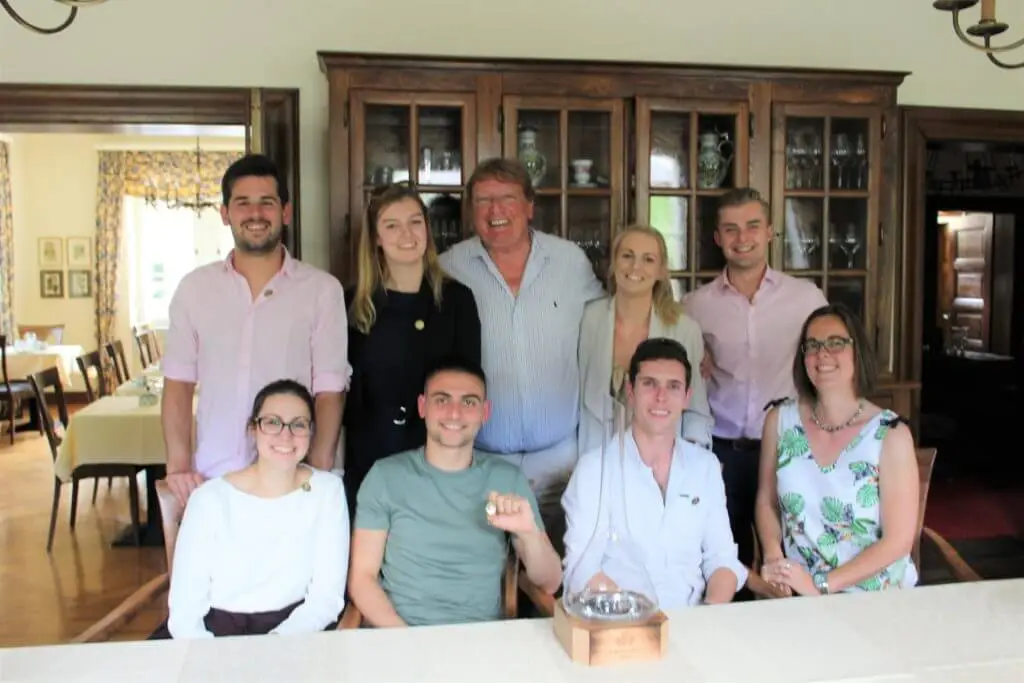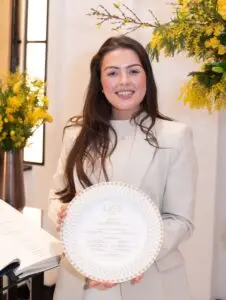As one of the most established wine producers in the Mosel region, S.A Prüm is steeped in history. Its 40-acre family-owned estate is home to some of the most unique Rieslings in the area. The family recently hosted our finalists as part of a special study trip, giving them the opportunity to learn about the wine and the region that it is produced in.
We caught up with Saskia Prüm, owner of S.A Prüm, who shares the story behind the wine, and why they are supporters of the Gold Service Scholarship.
Tell us a bit about the background of S.A. Prüm.
The family name dates back to 1156 when it first appeared in records but we believe it stretches back further than that, coming out of the town of Prüm in the Eifel region, just a 45 minute drive from Mosel.
In 1842, Jodocus Prüm, one of our great grand ancestors, built the Sonnenuhr (sundial) in the very best part of the vineyards on a great rock facing south. He liked to show people living in the valley the time of the day.
Your vineyard’s 40-acre estate is principally planted with Riesling. What are the unique characteristics of this particular grape and how does that translate into your wines?
We are very proud of cultivating the Riesling grape as this is the queen of white wines.
Our wine region, called ‘Mosel-Saar-Ruwer’ is named after the Mosel river and its two tributaries, Ruwer and Saar.
Nowadays, it has been changed to just ‘Mosel’ and it is here that the very best white wines from Riesling are produced. They have become famous round the world.
As we are located so far north, we have the perfect climate to produce our outstanding Riesling, which – as I like to say – prefers warm feet but a cool head. That means it doesn’t like it too hot in the ripening season.
Cool nights, slaty soil and a very long ripening period from at least 115 to 125 days create the flavour and aroma of perfect Riesling wines, while Napa in California has only 90 days of ripening time. The longer the grapes are on the vine, the more intense fruit structure is granted to the wine. Of course, we grant our wines an extra long temperature controlled wild yeast fermentation and a long stay on the lees for up between seven months and two years. Furthermore, a lot of our wines are fermented to dry as this allows both great food pairings and long ageing potential.
What is it about the terroirs of your estate and the Riesling grape that makes such a perfect match?
All of our Riesling grapes grow on the steepest hill side on Devonian slate along the river banks of the Mosel river. Different kinds of slate create a very special character. We have vineyards covered with: red slate in Ürzig, which has elements of iron oxide and gives warmth and spiciness; blue slate in Erden and Bernkastel, which has elements of copper oxide that gives weight and power; and grey slate in Wehlen and Graach, which has elements of tin oxide that gives elegance and delicacy.
Another very important fact is that ungrafted root stocks are very dominant at our winery.
Up to 130-year-old vines grant a lot of character but also an extremely light production of outstanding wines.
S.A. Prüm is a family affair, producing wines since 1911. What does keeping it in the family bring to the business?
1911 was the year of our first heritage in the extremely long history of the family. All of my grandfather’s brothers and sisters decided to take their share out of the S.A. Prüm winery and make themselves independent by creating their own winery. The Prüm family has always exported a lot of its Riesling production global wide and so do I. We are selling more than 95% of our wines round the globe.
How important is service to you as a wine producer and why?
Most of our wines are enjoyed in fantastic restaurants. This type of business is important to us as it helps us to spread the reputation of the family and the wines. So we need knowledgeable service to offer our wines to the wine connoisseurs all over the world.
One of the finalists said that they were very proud that a woman was leading such a successful wine brand. Is this unusual?
In 862 years, the winery has been led by men – this changed when my father handed over the winery to me on the 1st of July 2017. A nice number of wineries are owned and managed by women and this is more than great to see.
You built a bar at the top of the hill for locals to enjoy. How important was this to you?
This is a great meeting point to get the valley closer to the wine lovers. It is perfectly surrounded by vines and even located in one of the best spots in the area with a fantastic view all over our village and vineyards. It’s perfect for lunches and wine tastings.
Why is it important to you to support the Gold Service Scholarship?
The Gold Service Scholarship recognises the very best service people. They are young and enthusiastic, coming from great locations, serving the best wines from round the globe. This is our way of getting our wines back on the wine lists of the world.
How important is the Gold Service Scholarship to the wider hospitality industry?
All the people running the program are experts in hospitality and service. That’s a great sign for the hospitality industry in general. I hope even more of great young energetic people apply for the Gold Service Scholarship in the future.
Pictured: Saskia Prum with the 2019 Finalists and Raimund Prüm during their trip to the vineyard.



